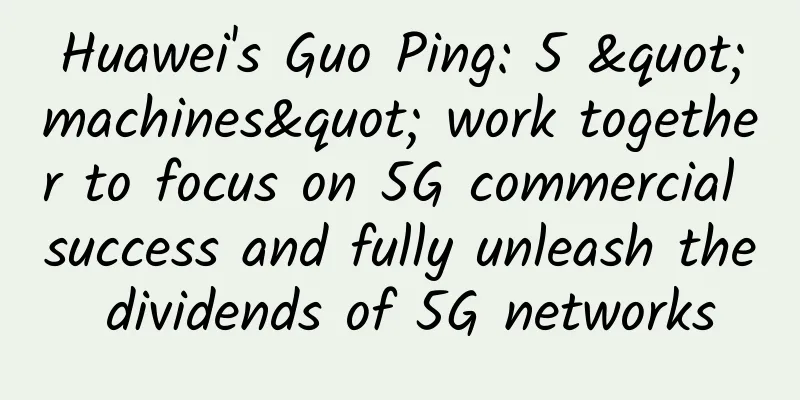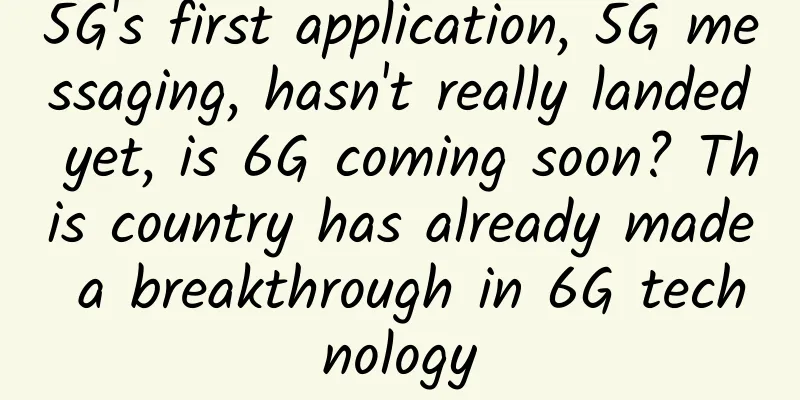How do you know if you are suitable for Wi-Fi 6 when it is about to be widely adopted?

|
Last year, the Wi-Fi Alliance broke the "rule" and launched Wi-Fi 6, which is what we often call 802.11ax before, and this new scheme will be used to name Wi-Fi in the future. As the sixth generation of Wi-Fi, Wi-Fi 6 has a maximum rate of up to 9.6Gbps, a 4-fold increase in the number of concurrent users, and a network latency reduction from an average of 30ms to 20ms. Now that Wi-Fi 6 is about to be widely popularized, which companies are more suitable for Wi-Fi 6? What should we pay attention to when deploying it? How 6 is Wi-Fi 6? Recently, Zeus Kerravala, founder of the well-known network research organization ZK Research, released a business white paper titled "Next Generation Wi-Fi 6 Super Connectivity for a Fast Future". The white paper believes that compared with previous generations of Wi-Fi technology, Wi-Fi 6 brings us a more comprehensive network experience and greater capacity; not only that, it will also help the development of the Internet of Things, while combining many innovative technologies such as AR/VR, cloud computing, and artificial intelligence, penetrating into various industries to better serve customers' business innovation. First of all, Wi-Fi 6 brings a significant increase in speed. What factors are related to Wi-Fi speed? As shown in the formula "Wi-Fi theoretical bandwidth = (symbol bit length × code rate × number of data subcarriers) × (1/transmission period) × number of spatial streams", the rate increase is mainly determined by several indicators such as modulation mode, number of data subcarriers, code rate, transmission period and spatial stream. The modulation method determines the data density of a single symbol of the wireless signal subcarrier. Under the same bandwidth, higher-order modulation technology can achieve higher rate increases. Wi-Fi 6 uses a higher-order modulation and coding scheme 1024-QAM (Wi-Fi uses 256-QAM), which increases its maximum connection rate to 9.6Gbps. In addition, the "6" in Wi-Fi 6 is also reflected in high-density access. It uses OFDMA (Orthogonal Frequency Division Multiple Access), which can divide the wireless channel into multiple sub-channels (subcarriers) to form frequency resource blocks. User data is carried on each resource block instead of occupying the entire channel, so that multiple users can transmit in parallel at the same time in each time period. Compared with the OFDM solution of Wi-Fi 5, which dispatches trucks based on orders, regardless of the size of the goods, one truck is dispatched for each order, even for a small piece of goods, which often results in empty carriages, low efficiency, and waste of resources. The OFDMA solution aggregates multiple orders and tries to load trucks fully, greatly improving transportation efficiency. By understanding the working mechanism of OFDMA, we can see that OFDMA enables multiple users to transmit data simultaneously, which increases the air interface efficiency. Next, let's take a look at the working principles of uplink OFDMA and downlink OFDMA respectively. Another very important aspect is that Wi-Fi 6 supports MU-MIMO, which is what we often call multi-user multiple-input and multiple-output, allowing the router to communicate with up to 8 devices at a time, and supporting both uplink and downlink MU-MIMO, without the need to communicate in sequence; in contrast, although Wi-Fi 5 also supports MU-MIMO, the router is only allowed to communicate with four devices at a time, and only supports downlink MU-MIMO. This may sound a bit abstract. Using traffic as an example, it means that the road is expanded from a 4-lane one-way road to an 8-lane two-way road. At the same time, multiple devices are no longer like many vehicles waiting in line to exit from an exit. They can exit/enter from different roads simultaneously and efficiently, instead of queuing up one by one, which greatly improves efficiency. However, it should be noted that although OFDMA and MU-MIMO both improve wireless access density for multiple users' uplink and downlink, there are actually big differences between the two. Although both are parallel transmission solutions, they are neither iterative nor competitive, but complementary. Their technical principles are different, and their applicable scenarios are also different. The specific use needs to be determined according to the application type of the service. Another manifestation of "6" is its anti-interference ability. We say that Wi-Fi signals are everywhere, which makes interference between wireless networks ubiquitous. On the one hand, the superposition of radio waves from adjacent frequency bands causes interference, which will cause data damage; on the other hand, there is co-frequency interference, which will not damage data but will increase competition overhead. On the surface, the cause of these interferences is that we often encounter many isolated APs in our environment, so there is a lot of cross-coverage of wireless signals, which causes interference; but from the technical principle level, the cause of the interference is that the traditional 802.11 technology uses carrier sense multiple access/collision avoidance technology (CSMA/CA) to implement access control. In order to solve the problem of poor performance of CSMA/CA technology in dense AP environments, Wi-Fi 6 proposes a channel spatial reuse technology (Spatial Reuse Technique), which uses the BSS (Basic Service Set) color bit to identify which BSS the data frame belongs to, so it is also called "BSS coloring" technology. Through the "BSS coloring" technology, wireless devices can use the newly added coloring bits to identify whether the incoming wireless message is from the BSS or OBSS (0verlapping Basic Service Sets) signal. In this way, the CCA-SD (Clear Channel Assessment Signal Detection) threshold between BSSs can be increased and the CCA-SD threshold within the BSS can be dynamically lowered to ignore the corresponding data frames of the OBSS. The reason why Wi-Fi 6 can help the development of the Internet of Things is that it supports TWT (Target Wakeup Time) technology. It allows APs to plan communications with devices, negotiate when and how long to wake up to send/receive data, and group terminals into different TWT cycles, reducing the time required to keep the antenna powered on to transmit and search for signals, which means reducing battery consumption and improving battery life performance, while also reducing the number of devices competing for wireless resources at the same time after waking up. In the future, smart water meters, smoke detectors, access control in smart building scenarios, machine tools, AGVs, in-and-out scanning devices, and other types of smart devices in smart factory scenarios can all be connected to Wi-Fi. Thanks to TWT, each device can establish a "wake-up protocol" separately. The terminal device will only enter the working state after receiving its own "wake-up" information, and will be in a dormant state for the rest of the time, which can save up to 7 times the battery power consumption. At the same time, this makes it possible for some IoT devices that require high-bandwidth communication, such as smart office equipment. TWT can save up to 7 times the battery power consumption. But TWT is not helpful for all devices. For example, laptops require continuous Internet access, so they are unlikely to benefit too much from this feature (perhaps the impact is greater when entering sleep state). It is more beneficial for small, low-power devices that occasionally need to update their status. Therefore, TWT technology shows Wi-Fi 6's determination to embrace the Internet of Things. Which companies should deploy Wi-Fi 6? Having said so much about the advantages of Wi-Fi 6, which companies should deploy Wi-Fi 6? Today, with the widespread application of technologies such as 4K video, automated guided vehicles (AGVs), and VR/AR, the demand for Wi-Fi experience in all walks of life is rapidly increasing. Compared with previous Wi-Fi technologies, Wi-Fi 6 is the first technical standard that enables enterprises to achieve full wireless connectivity. All devices and applications of the enterprise can achieve network connection through Wi-Fi 6. Before deploying WiFi 6, make preparations in the following aspects: First, make sure the wired network is secure. Key features required for wired networks include Ethernet power supply that meets the PoE+ standard and multiple GE interfaces (1/2.5/5GE). In addition, when you consider Wi-Fi 6, unified management becomes indispensable; in addition, operation and management based on artificial intelligence. Wi-Fi 6 enables enterprises to achieve hyper-connectivity, and the disadvantage of hyper-connectivity is that it is unusually complex, so artificial intelligence operation tools are a necessary condition for the success of Wi-Fi 6, such as Huawei's CampusInsight: Secondly, it is to connect enterprise networks with the Internet of Things. The demand for digital transformation and the Internet of Everything will eventually integrate all networks. Network experts should understand the scale of these networks, the protocols used (such as BLE, Zigbee, etc.), and security risks, and prepare in advance. Therefore, we recommend that companies that are still using Wi-Fi 4 (802.11n) or earlier versions of the Wi-Fi standard should go all the way and directly deploy Wi-Fi 6, which is more economical. For those pioneering companies that are technology pioneers, such companies are mainly in highly competitive industries such as higher education, luxury retail, and entertainment venues. Poor performance wireless networks may lead to poor customer experience and quickly switch to competitors. The third category is companies that use high-bandwidth and immersive applications. For example, companies or institutions that use high-definition video or AR for customer service or collaboration, as well as remote 3D medical care, VR/AR immersive teaching, and unmanned warehousing all have a demand for Wi-Fi 6. Another category is institutions that are building high-density wireless networks: such institutions include public places, universities, stadiums, and theaters. Older versions of Wi-Fi are unlikely to meet the requirements, but using Wi-Fi 6 makes it possible. Okay, that’s all for this issue. |
>>: Understand TCP, UDP and port numbers in 10 minutes
Recommend
When to use 5G and Wi-Fi 6?
We’ve seen a lot of hype around 5G cellular and W...
The intelligent world is waiting for you to build. Huawei Cloud joins hands with millions of developers to Login 2020
What does an intelligent world where everything i...
What is edge computing? Why is it called the gas station in the era of smart IoT?
With the rapid development of the Internet of Thi...
TmhHost adds dual ISP US home broadband VPS native IP/AS9929 backhaul monthly payment starts from 50 yuan
This month, TmhHost added dual ISP home broadband...
Megalayer: Hong Kong/Philippines/USA/Singapore special VPS starting at 199 yuan per year, native IP starting at 249 yuan per year
Megalayer promotional VPS packages are being rest...
Even monkeys can penetrate the intranet!
Hello, everyone, I am amazing. I recently turned ...
Why do we need a Layer 3 switch? Seven indicators for selecting a Layer 3 switch in a monitoring system
Recently, a friend asked about the application of...
Mobile phone signal enhancement stickers are hot-selling, experts: The principle is not valid, and there is no obvious enhancement in actual measurement
Just stick a metal sticker on the "effective...
Juniper Networks will aggressively enter the OTT market in 2018, connecting the world with secure and efficient networks
[51CTO.com original article] From June 7 to 8, 20...
[11.11] UUUVPS special VPS annual payment starts from 128 yuan, Hong Kong/US 9929/4837/CN2 and other options
UUUVPS (SanYou Cloud) is a registered Hong Kong c...
What is the difference between a wireless access point and a wireless router?
[[183847]] There is a distinct difference between...
Breaking news: Why has Huawei LampSite won the GlobalData Indoor Small Site Rating for three consecutive years?
Recently, GlobalData, a telecommunications indust...
Talk丨Can positioning become a new growth point for LoRa technology?
First, an example: If you and your good friend ma...
OlinkCloud: San Jose dedicated server 60% off monthly payment starting at $71.4, triple-network AS9929 line
Olink.Cloud is a site under the old host company ...
How does Sentinel intercept abnormal traffic?
[[342079]] When you use electricity at home, you ...









